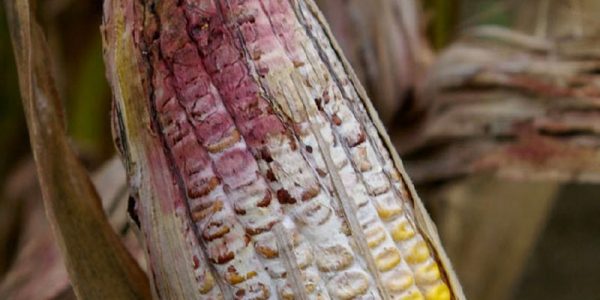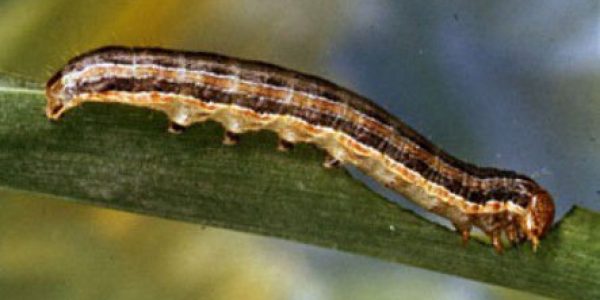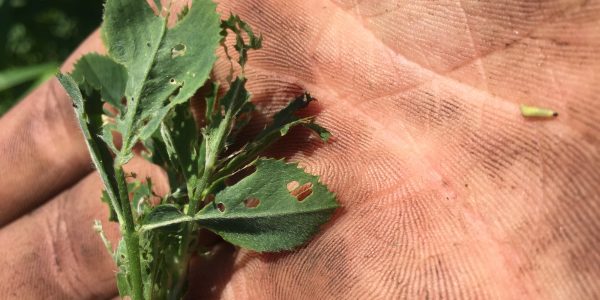Gibberella
What is it and How is it Caused?
Gibberella ear rot is a mold that affects corn ears. It is caused by the fungal pathogen Gibberella zeae.
Scouting for Gibberella
Scout throughout the season and just before harvest. Look for mold at the tip of the ear that appears pink to reddish and extends down the cob towards the base.
Mycotoxins
The problem with gibberella ear mold is that it can produce two mycotoxins in the infected kernels called deoxynivalenol (vomitoxin) and zearalenone. However, this is not always the case. You can have gibberella ear rot in your field and not have any mycotoxin present. So, how do you predict whether you have a potential mycotoxin problem? Sadly, there's no sure-fire way of knowing until after harvest but, Greg Stopps, area agronomist for SW Ontario with Pioneer® states:
"my personal speculation . . . is that VOM production is a survival or defense mechanism in the face of some currently unknown stressors on the fungus itself - the more the fungus is challenged the more VOM it produces (research is needed to prove this)"
If you have a high level of Gibberella ear rot, you have a higher chance of having vomitoxin present.
Vomitoxin can cause swine and other animals to refuse or vomit feed (thus the name, ‘vomit’oxin). Below is a table outlining acceptable levels of vomitoxin for livestock. Zearalenone affects more of the reproductive system in livestock since it has estrogenic properties. It can cause infertility, abortion and other breeding problems in livestock.
Table 1. Allowable limits (ppm) of mycotoxin in feed
| Livestock | Vomitoxin (DON) | Zearalenone |
| Nursery pigs | 0.5 | 0.5 |
| Finishing pigs | 1.0-2.0 | 2.0 |
| Breeding pigs | 1.0 | 0.5 |
| Cattle | 5.0 | 10.0 |
| Poultry | 5.0 | NA |
| Young calves | 1.0 | 10.0 |
| Lactating dairy animals | 1.0 | 0.5 |
| Sheep | 5.0 | 0.25-5 |
Source: OMAFRA, Canadian Food Inspection Agency, 2017
How did Gibberella Become Such a Problem?
And was there anything we could have done differently? Likely, the answer is no, with the information we have available. But what happened this year as opposed to other years? The drought this spring weakened plants making them more susceptible to disease and also delayed silking. Exposed, unpollinated silks later in the season left corn susceptible to infection. Drought stress also made corn husks tighter and longer than the cob. Long, tight husks create a perfect, moist environment for disease. Add all of this to the fact that we had a warm, humid August and you have a perfect recipe for Gibberella development.
Steps to take if you have mycotoxin in your corn
Notes from Holly Loucas, Pioneer® area agronomist:
“Open-up the combine and get as much fine particles out of the back. Even small kernels at the top of the cob need to go out the back if infected with gibberella. You can drop vomitoxin 50% by doing this.
If possible, you can also blend with the 2019 corn crop”
It’s hard to predict if you have any mycotoxin in your corn since giberella ear rot does not always produce a mycotoxin. The only way to know for sure is to perform a test on the infected grain. Twenty View Farms is taking steps to be able to test corn for VOM levels.
After Harvest
If you have gibberella ear rot in your field, the best way to prevent a re-occurring incident is to till corn after harvest. Crop rotation with a non-host crop, such as soybeans, is also encouraged to break-up the disease cycle.
If you are worried about gibberella in the future, there are also varietal differences in gibberella resistance between corn varieities. Feel free to contact Daryl Haanstra (905-973-0036) or Jordan Eyamie (905-966-9608) to ask about what Pioneer® corn variety would work best for your operation.
Author: Jordan Eyamie
November 1st, 2018
Related Articles
Armyworm
Are you checking your fields for armyworm?
Here's the information you need on identification, favourable environments, and control methods.



